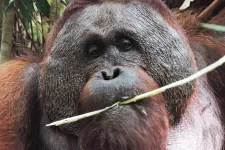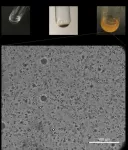(Press-News.org) COLUMBUS, Ohio - A new study's findings dispel the misconception that patients and providers are at high risk of catching COVID-19 at the dentist's office.
SARS-CoV-2 spreads mainly through respiratory droplets, and dental procedures are known to produce an abundance of aerosols - leading to fears that flying saliva during a cleaning or a restorative procedure could make the dentist's chair a high-transmission location.
Ohio State University researchers set out to determine whether saliva is the main source of the spray, collecting samples from personnel, equipment and other surfaces reached by aerosols during a range of dental procedures.
By analyzing the genetic makeup of the organisms detected in those samples, the researchers determined that watery solution from irrigation tools, not saliva, was the main source of any bacteria or viruses present in the spatter and spurts from patients' mouths.
Even when low levels of the SARS-CoV-2 virus were detected in the saliva of asymptomatic patients, the aerosols generated during their procedures showed no signs of the coronavirus. In essence, from a microbial standpoint, the contents of the spray mirrored what was in the office environment.
"Getting your teeth cleaned does not increase your risk for COVID-19 infection any more than drinking a glass of water from the dentist's office does," said lead author Purnima Kumar, professor of periodontology at Ohio State.
"These findings should help us open up our practices, make ourselves feel safe about our environment and, for patients, get their oral and dental problems treated - there is so much evidence emerging that if you have poor oral health, you are more susceptible to COVID," Kumar said.
The study was published Wednesday, May 12, in the Journal of Dental Research.
Previous research has shown that dental-procedure aerosols tend to land on providers' faces and the patient's chest, and can travel as far as 11 feet. But the studies, catching the spray in petri dishes placed on people, equipment and around the room, found only that bacteria existed - they rarely identified the organisms and never determined where they came from. Saliva has been the presumptive source for a long time.
When saliva was considered potentially deadly at the start of the pandemic, Kumar decided a long-term answer was needed to settle the question of whether saliva is the source of dental aerosols.
For the study, the team enrolled 28 patients receiving dental implants and restorations using high-speed drills or ultrasonic scaling procedures in Ohio State's College of Dentistry between May 4 and July 10, 2020. Researchers collected samples of saliva and irrigant (the water-based cleaning solutions used to flush out the mouth) before each procedure and, 30 minutes after the procedure, aerosol remnants - condensate - from providers' face shields, the patient's bib and an area 6 feet away from the chair.
Kumar and colleagues then put genome sequencing technology to use that wasn't available in the petri-dish days. This allowed them to first characterize the microbial mix in pre-procedure saliva and irrigants, which they could then compare to organisms in the aerosol samples collected later.
With the analytical method they used, the researchers did not need to characterize the microbes - they instead looked for variations in sequences that provided enough information to identify the family of bacteria or viruses to which they belonged.
"Some species that live in your mouth can closely resemble those in water and the environment. Using this method, we don't even have to know the names of these organisms - you can tell whether they are exactly genetically identical or genetically different," Kumar said. "If you use this granular approach to see these very nuanced differences in the genetic code, you can very accurately identify where they're coming from."
No matter the procedure or where the condensate had landed, microbes from irrigants contributed to about 78% of the organisms in aerosols while saliva, if present, accounted for 0.1% to 1.2% of the microbes distributed around the room.
Salivary bacteria were detected in condensate from only eight cases and of those, five patients had not used a pre-procedural mouth rinse. The SARS-CoV-2 virus was identified in the saliva of 19 patients, but was undetectable in aerosols in any of the cases.
The findings are reassuring, but also make sense, Kumar said: Irrigant dilutes saliva - a "thick, viscous" substance - by an estimated 20- to 200-fold, and the research is validated by a 2020 study that reported a less than 1% COVID-19 positivity rate among dentists.
Kumar noted that dentistry has long been at the forefront of infection-control practices in health care. During the pandemic, new protocols have included strengthened ventilation systems, extra aerosol suction equipment, N95 masks and face shields on top of goggles, and extended downtime between patients. She is hopeful this study's findings will make practitioners and patients feel at ease about being in the dentist's office - with continued stringent protection in place.
"Dental surgeons and hygienists are always at the forefront of the war against bacteria in the mouth, and they of course did not feel safe because they are front-line workers surrounded by aerosol," said Kumar, who has a periodontology practice of her own and was one of the procedure operators in the study.
"Hopefully this will set their mind at rest because when you do procedures, it is the water from the ultrasonic equipment that's causing bacteria to be there. It's not saliva. So the risk of spreading infection is not high," she said. "However, we should not lose sight of the fact that this virus spreads through aerosol, and speaking, coughing or sneezing in the dental office can still carry a high risk of disease transmission."
INFORMATION:
Co-authors of the study include Archana Meethil, Shwetha Saraswat and Shareef Dabdoub of Ohio State and Prem Prashant Chaudhary of the National Institute of Allergy and Infectious Diseases.
Contact: Purnima Kumar, Kumar.83@osu.edu; 614-247-4532
Written by Emily Caldwell, Caldwell.151@osu.edu; 614-292-8152
Twenty-seven years ago, more than 1 million Rwandans were killed during the genocide against the Tutsi in Rwanda from April 7 to July 4, 1994. It is estimated that 100,000 to 250,000 women were raped during the 100-day genocide, and that 10,000 children were born as a result. A new study finds that Rwandans who were conceived by mothers who survived the 1994 genocide against the Tutsi have poorer adult health outcomes than those who were conceived by Rwandan mothers living outside the country at that time. In addition, those who were conceived through genocidal rape have poorer adult health ...
DALLAS, May 13, 2021 -- Higher body mass index (BMI) in adolescence is associated with a significantly higher risk of first ischemic stroke in adults under age 50 regardless of whether they had Type 2 diabetes, according to new research published today in Stroke, a journal of the American Stroke Association, a division of the American Heart Association.
While rates of adolescent obesity and stroke among adults under the age of 50 years continue to rise around the world, the precise link between the two conditions is still not fully understood.
"Adults who survive stroke earlier in life face poor functional outcomes, which can lead to unemployment, depression and anxiety," said study co-author Gilad Twig, M.D., M.P.H., Ph.D., an ...
It's a tough time to be a shark. Pollution, industrialized fishing, and climate change threaten marine life, and the populations of many top ocean predators have declined in recent years. In addition to studying sharks in the wild, scientists working to save sharks rely on ones living in zoos and aquariums so that they can help build breeding programs and learn more about the conditions sharks need to thrive. One important way the scientists do that is by playing matchmakers to the sharks, pairing up individuals in ways that increase genetic diversity. In a new study in Scientific Reports, scientists undertook the largest-ever effort to artificially inseminate sharks.Their work resulted in 97 new baby sharks, ...
Wild orangutans are known for their ability to survive food shortages, but scientists have made a surprising finding that highlights the need to protect the habitat of these critically endangered primates, which face rapid habitat destruction and threats linked to climate change.
Scientists found that the muscle mass of orangutans on the island of Borneo in Southeast Asia was significantly lower when less fruit was available. That's remarkable because orangutans are thought to be especially good at storing and using fat for energy, according a Rutgers-led study in the journal Scientific Reports.
The findings highlight ...
All modern life is composed of cells, from single-celled bacteria to more complex organisms such as humans, which may contain billions or even trillions of cells, but how life came to be cellular remains uncertain. New research led by specially appointed assistant professor Tony Z. Jia at the Earth-Life Science Institute (ELSI) at Tokyo Institute of Technology, along with colleagues from around the world (Japan, Malaysia, France, Czech Republic, India and the USA), shows that simple chemical compounds known as hydroxy acids, which were likely common on primitive Earth, spontaneously link together ...
Scientists have begun the search for extraterrestrial life in the Solar System in earnest, but such life may be subtly or profoundly different from Earth-life, and methods based on detecting particular molecules as biosignatures may not apply to life with a different evolutionary history. A new study by a joint Japan/US-based team, led by researchers at the Earth-Life Science Institute (ELSI) at the Tokyo Institute of Technology, has developed a machine learning technique which assesses complex organic mixtures using mass spectrometry to reliably classify them as biological or abiological.
In season 1, episode 29 ("Operation: Annihilate!") of Star Trek, which aired in 1966, the human-Vulcan hybrid character ...
PULLMAN, Wash. - Rush hour will likely return when pandemic lockdowns lift, but a new study suggests that congestion pricing--policies that charge tolls for driving during peak hours--could not only cure traffic jams but also convince motorists it is safe to buy smaller, more efficient cars.
Researchers from Washington State University and the Brookings Institution studied a sample of nearly 300 households in the Seattle area over a six-year period, finding that the more congested their commutes, the more likely they would buy bigger cars which they perceive as safer and more ...
New research presented at this year's European Congress on Obesity (held online, 10-13 May) shows that the obesity drug semaglutide reduces appetite, food cravings and energy intake in people given a meal where they could eat as much as they liked. The study is by Dr Dorthe Skovgaard, Novo Nordisk A/S (the manufacturer of the drug), Søborg, Denmark, and colleagues.
Semaglutide, in the glucagon-like peptide-1 (GLP-1) analogue drug class, is currently available at the dose of 1.0 mg injected once weekly for the treatment of type 2 diabetes and is under development for chronic weight management at the dose ...
An early study of a new experimental drug to treat obesity known as cagrilintide shows that, when combined with semaglutide 2.4 mg, the combination leads to more weight loss than semaglutide 2.4 mg alone and is well tolerated. This phase 1 study, which was recently published in The Lancet will be presented at this year's European Congress on Obesity (held online, 10-13 May) by Dr Lone Enebo, Novo Nordisk A/S, Denmark, on behalf of her colleagues. Novo Nordisk A/S is the manufacturer of both drugs in this study.
Combining medications with different modes of action may provide more effective treatment options for people with obesity. Weekly injections of cagrilintide, ...
Two-thirds of California prisoners who were offered a COVID-19 vaccine accepted at least one dose, according to a new study by researchers at the Stanford University School of Medicine.
"We found that many incarcerated people in California prisons were willing to be vaccinated for COVID-19," said Elizabeth Chin, the lead author of the study and a PhD candidate in biomedical data science. "This is an encouraging sign for other states at an early stage of rolling out vaccination programs in their prisons and jails."
The researchers also found that nearly half of those who initially turned down a COVID-19 vaccine accepted it when it was offered to them again. The finding is an important indication that vaccine hesitancy is not necessarily fixed.
Two-thirds ...



